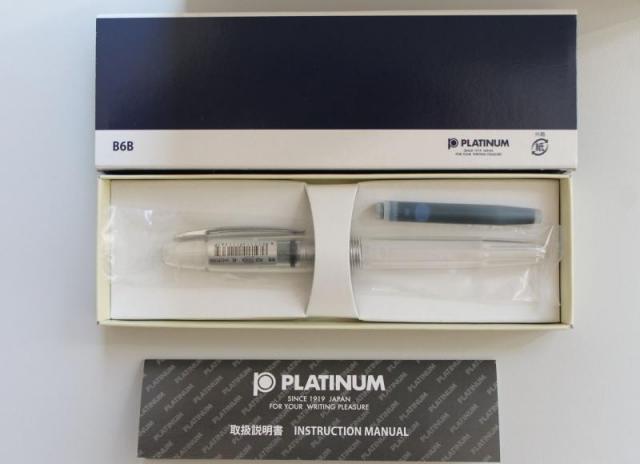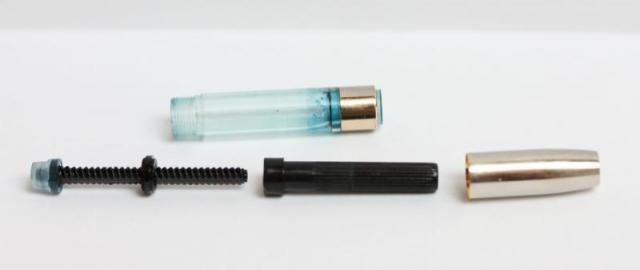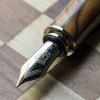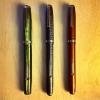Search the Community
Showing results for tags 'clear'.
-
(filled with Rohrer & Klingner Alt Bordeaux) Demonstrators are not really my area. I do somewhat appreciate them as a sort of curiosity, but I prefer more traditional finishes and colors. That being said, a piston filling demonstrator does seem like an interesting idea, and since I've never had on...
- 4 replies
-
- caliarts ego
- piston filler
-
(and 3 more)
Tagged with:
-
I already had some staining on one from Noodler's black, and had some shimmer left over in another one from Colorverse's Gluon, both inside the barrel where the small grooves are. What are the inks I should definitely stay away from if I don't want to permanently stain the barrel? Are th...
-
There are some reviews on the Platinum Cool, which is also known as Platinum Balance, on FPN and other places. Nevertheless I think adding one more might contribute some more information, another perspective, experience and pictures. I had this pen in fine and medium and now use the fine for more th...
-

What Is Your Favorite Clear/transparent Pen?
tgoto posted a topic in Fountain & Dip Pens - First Stop
I have a thing about clear/transparent pens. They don't necessary have to be a demonstrator, but any clear parts attract me. My favorites so far are Omas 630, Franklin Christoph P66 with Italian Ice and Stipula Etruria Blue. What is your favorite clear/transparent pen(s)?- 97 replies
-
- clear
- transparent
-
(and 2 more)
Tagged with:
-
Hello everyone, I would love to see photos of rare demonstrators (both vintage and modern) in the same topic. Since it's been 3 years (already!) since Kenshiro shared his brilliant collection (https://www.fountainpennetwork.com/forum/topic/276249-demonstrator-festival-2014/), I think it's worth...
- 10 replies
-
- demonstrator
- transparent
-
(and 1 more)
Tagged with:
-
I saw this YouTube video about the Pilot Kakuno with demonstrator/clear/transparent body. Is anyone else really excited for this pen? I like Pilot steel nibs. I like demonstrator pens. And, I like the comfort of the Kakuno pen body. https://www.youtube.com/watch?v=EkNjCHH7K7Q
-
Hi everyone! I'm in the market for a nice Senior sized striped duofold. I'm particularly interested in the blue pearl version! Are there any places in Australia who may have a nice one of these? Or anywhere great in the states or other overseas areas? I have been waiting for a reasonable one on...
-
With the latest Twsbi Eco making news, I decided to give my old 580 another shot just to make sure whether I should go for another. Find one is good enough for me (personal opinion). Here is also a link to my blog: TWSBI Diamond 580 Review Here goes my review of the 580: My sole motivation beh...
- 39 replies
-
Hello all, I have a TWSBI Mini with a Medium nib and, some time ago, lost the o-ring on the piston knob that prevents over-tightening of the cap upon posting. Does anybody know where I can buy a replacement o-ring, or am I just SOL? On the attached image, I marked where the o-ring is normally lo...
-
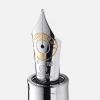
Which Pen Do You Wish Came In Demonstrator?
phillieskjk posted a topic in Fountain & Dip Pens - First Stop
Which pens do you wish came in demonstrator versions, but don't already? Personally, I'd love to see a demonstrator Jinhao X450 or a demonstrator Vanishing Point. -

Goulet Pen Flush Vs. Pilot Custom Heritage 92
Peppers posted a topic in Fountain & Dip Pens - First Stop
I got a Pilot Custom Heritage 92 Clear Demonstrator for christmas. Do I run into any danger zones if I use the Goulet Pen Flush to clean up my CH 92? Beautiful pen, will probably be my favorite from now on. My common sense tells me that: 1. Flush chemicals may haze the clear plastic. 2. Flush...- 16 replies
-
- goulet pen flush
- ch 92
-
(and 4 more)
Tagged with:
-
sup ppl. So I got an Ahab and my oh my! Those 20 dollars are worth every cent and more... I even love the smell. Reminds me of my grandpa's Vacumatic. I swapped the stock "flexi" nib for Zebra G and the thing became insane! Couldn't be happier. One question to other Ahab owners though... I firs...
-
Advice Wanted On Cheap Pen For Work. Ef, Preferably Demonstrator.
Cyclopentadiene posted a topic in Fountain & Dip Pens - First Stop
Hi all, Backstory: I've recently changed job location and gave away the pens I had to my colleagues. Now I need another pen at my new location and thought it a good idea to try a fountain pen in the lab. But which one?!? Needs: - The pen really needs to have an extra fine nib and be able to take... -
One of my recent Sheaffer acquisitions has a very hazy, fuzzy ink view, pretty much opaque unless held up to light. I believe it has been heat or environmentally exposed to make it that way. Is it possible to sand/polish off or treat the hazy part to get a clearer ink view underneath? Not a crucia...





